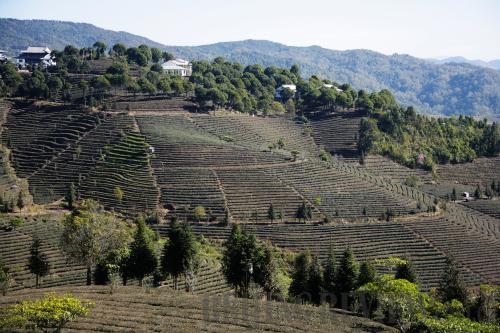|
Regional achievements
 |
|
ACHIEVING PROSPERITY: A large tea farm provides economic and environmental benefits to Pu'er, Yunnan Province. The Western Development plan calls for continued efforts to protect the environment (WANG XIANG) |
Since the implementation of the Western Development Strategy, the region has witnessed more economic and social changes than at any other point in its history.
From 2000 to 2008, the western region's GDP grew at an average annual rate of 11.7 percent, 1.77 percentage points higher than the country's average. The proportion of the region's GDP increased from 17.1 percent to 17.8 percent of the country's total.
Breakthroughs in infrastructure construction have also been made, with nearly 13,900 km of newly built expressways connecting 98.3 percent of townships and 81.2 percent of villages by the end of 2008. The intensity of highway networks has reached 20.7 km per 100 square km, 2.65 times 1999 figures.
Newly added business railway mileage totaled nearly 9,000 km. Among all the railways in the region, 23.2 percent are double-track railways and 38.8 percent are electric.
Twelve trunk line airports and 30 feeder line airports were transformed or enlarged, and an additional 21 feeder line airports were built to address transportation needs and form an airport system in the western region.
Fixed telephone and mobile telecommunications increased from 7.1 to 58.9 telephones per 100 persons.
Marked effects have been achieved in ecological construction and environmental protection. Various ecological projects have restored cultivated land to forests and pastures to grasslands, protected natural forests and established a Beijing-Tianjin sandstorm source control project. Forests, grasslands and vegetation in the western region have been increased and restored, soil erosion reduced, and wind and sandstorm damages alleviated.
The region's industrial sector has also undergone a transformation. Processing bases with strong local characteristics and market competitiveness, such as cashmere and dairy products in Inner Mongolia, cotton textiles and tomato sauce in Xinjiang, fruits and vegetables in Shaanxi, sugar making in Guangxi and Yunnan, breweries in Sichuan and Guizhou, as well as traditional Chinese medicine in Guangxi and Yunnan, have developed since 2000.
The establishment of utilization bases for superior mineral resources, such as sylvite, non-ferrous metals, phosphor and rare earth, have helped spur the region's mining industry.
The Chinese Government has also actively promoted the development of the aviation and aerospace, new energy, biological engineering and electronic information industries and supported the construction of 25 hi-tech industrial bases.
Much-needed changes have also been made to the public service system, primarily focused on public education, medical services and the social security network. The rate of students who complete compulsory education has increased from 74.5 percent to 92 percent. High school admissions have also improved, with a rate increase from 61.3 percent to 80 percent.
A medical service system has been established covering medical institutions at the county, township and village level. A social security network covering urban and rural residents is currently in the works, with coverage of endowment insurance for urban employees, basic medical insurance, unemployment insurance, workers' compensation insurance and maternity insurance being expanded.
But perhaps the most impressive aspect of the development strategy has been the changes to the urban and rural landscape. Road networks now connect cities and communities throughout the region. By the end of 2008, the tap water supply rate in urban areas had reached 86.7 percent, up 40 percentage points from 2000's rate; the sewage disposal rate had reached 54.7 percent, up 20 percentage points; and the rate of bio-safety disposal of household refuse reached 67.8 percent. The communications infrastructure has also experienced an unprecedented expansion, as 98 percent of villages in the western region have telephone access.
Future considerations
Aside from the list of achievements from the past decade, problems still surround the Western Development Strategy. Environmental shortfalls still exist, the inadequate capability of self-development has not been fundamentally changed and basic public services are still weak as the number of people stricken by poverty is still relatively high. Strengthening national unity and maintaining stability in the border areas has also proved to be an arduous task.
The momentum of widening the development gap between the western region and developed coastal area also needs to be reversed if China is to build a prosperous, well-rounded society. But with the success of the first 10 years, a promising outlook awaits the upcoming decade for the Western Development Strategy.
The author is Director of the General Office of the Department of Western Region Development of the National Development and Reform Commission | 